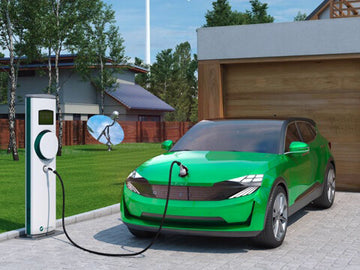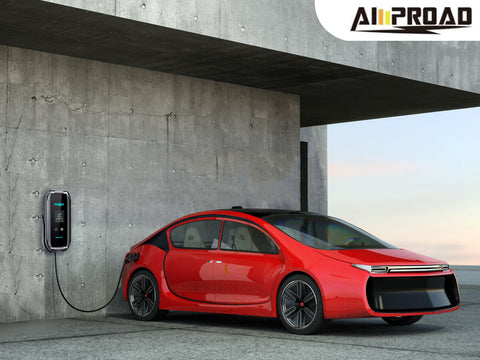
Ford's decision to offer free Tesla to CCS adapters for its electric vehicles has sparked curiosity. Is it simply a customer perk or a strategic move in the rapidly evolving EV market? This article dives into the potential implications. We'll explore how this strategy might impact charging infrastructure, the future of charging standards, and ultimately, who benefits the most – Ford, Tesla, or the consumer? Fasten your seatbelt as we unpack Ford's surprising move in the world of electric vehicle charging. (138 words)
Leveling the Field?

Ford's free Tesla to CCS adapter has raised eyebrows. Is it simply a customer perk, or a strategic move in the electric vehicle (EV) chess game? Let's explore the potential implications, starting with the idea of leveling the playing field.
Does the adapter bridge the gap to Tesla's Supercharger network for Ford owners?
Tesla's Supercharger network is a major advantage, offering extensive fast-charging coverage for long-distance travel. Ford currently lacks a comparable network of its own. The free adapter allows Ford drivers to access this vast network, potentially bridging the gap in charging accessibility, especially for road trips.
Does NACS access offer comparable charging experiences, especially for long trips?
The adapter grants Ford customers access to NACS fast-charging stations, not just Tesla's Supercharger network. While convenient for long trips, NACS charger availability might not yet match the sheer number of Supercharger stations. Additionally, using Tesla's network might involve fees, unlike some public NACS stations.
How will this impact consumer perception of Ford's EV charging commitment?
Ford's move could significantly impact consumer perception. It shows a proactive approach to addressing concerns about charging infrastructure, especially for long-distance travel. However, relying on Tesla's network might raise questions about Ford's long-term commitment to building its own robust NACS charging infrastructure.
The free adapter offers undeniable convenience, but it's important to consider the bigger picture. We'll delve deeper in the next section, exploring the potential impact on charging infrastructure and the future of charging standards.
Speed vs. Convenience?
The free adapter presents an interesting question: speed versus convenience. NACS charging offers undeniable advantages – it's significantly faster than a standard Level 2 EV charger you might have at home. This translates to shorter charging times on long trips, a major benefit for EV ownership.
Does NACS prioritize fast charging over Level 2 home charging convenience?
However, NACS isn't a replacement for a Level 2 EV charger at home. Level 2 chargers offer slower but convenient overnight charging, perfect for topping off your battery before daily commutes. The adapter prioritizes fast charging for long journeys, but doesn't eliminate the need for a convenient home charging solution.
What are the trade-offs for Ford customers using Tesla's network vs. building a Level 2 network?
Ford's strategy presents trade-offs. While the adapter offers access to Tesla's extensive network, it might involve fees for using Superchargers. Additionally, relying on another company's infrastructure raises questions about long-term control and future availability. On the other hand, building a robust Level 2 network takes time and significant investment.
Will this shift consumer behavior towards prioritizing fast-charging availability?
The easy access to fast charging through the adapter could potentially shift consumer behavior. However, the importance of convenient home charging for daily needs remains. It's likely that a combination of solutions – a reliable Level 2 EV charger at home and access to fast-charging stations for long trips – will continue to be the ideal scenario for most EV drivers.
This highlights the need for a diverse EV charging infrastructure. In the next section, we'll explore the potential impact of Ford's move on the future of charging standards and the dominance of CCS.
The CCS Gamble?
The free adapter throws another variable into the already complex equation of charging standards. Here, we explore the potential impact on the dominance of CCS.
Does the adapter solidify CCS as the standard, sidelining Level 2 chargers?
The focus on NACS charging through the adapter could raise concerns about the future of Level 2 chargers. However, it's important to remember that NACS is designed for fast charging on long trips, while Level 2 chargers excel in convenient home or workplace charging. Products like the AMPROAD portable Level 2 EV charger further blur the lines, offering flexibility for both home and travel charging needs. NACS and Level 2 solutions likely cater to different charging scenarios, and both might coexist in the future.
How will this influence future EV infrastructure investments by Ford and others?
Ford's move could influence future infrastructure investments by automakers and charging network providers. The immediate benefit of offering NACS access through the adapter might overshadow the need for a robust Level 2 charging network buildout by Ford. However, the long-term viability of relying solely on another company's network (Tesla's Superchargers) is questionable. This might incentivize Ford to invest in its own CCS charging infrastructure alongside promoting NACS compatibility for a more comprehensive solution.
Is the adapter temporary until a CCS network is built, or a long-term CCS commitment?
The true intent behind the free adapter remains unclear. It could be a temporary solution to bridge the gap until a more comprehensive CCS network is established. This strategy allows Ford to offer fast-charging capabilities to its customers without the immediate investment in building their own infrastructure. However, it's also possible that the adapter signifies a long-term commitment to CCS by Ford, signaling a belief in its dominance as the future standard.
The coming years will reveal the true impact of Ford's strategy. Will it solidify CCS dominance, or will we see a future with multiple charging solutions coexisting to meet the diverse needs of EV drivers?
Sustainable Solution?

The free adapter raises questions about long-term cost-effectiveness. Let's delve into the financial implications for Ford customers.
Is the adapter a cost-saver for Ford customers in the long run (considering network fees)?
The adapter offers undeniable convenience, but using Tesla's Supercharger network, a prominent example of a DC fast-charging EVCS (Electric Vehicle Charging Station), might involve fees. These fees could potentially outweigh the initial cost of installing a home Level 2 EV charger, especially for frequent long-distance travelers. Additionally, relying on another company's network introduces uncertainty about future pricing structures for EVCS usage.
How do network fees and limitations compare to a home Level 2 charger investment?
While the adapter grants access to a vast network of EVCS, Tesla Superchargers might not always be readily available, especially in remote locations. In comparison, a home Level 2 charger offers the convenience and predictability of overnight charging at a fixed cost, potentially offsetting the initial investment over time.
Who benefits most: Ford, Tesla, or the consumer?
The ultimate beneficiary of Ford's strategy remains to be seen. Ford gains a competitive edge by offering fast-charging capabilities without a hefty upfront investment in building its own EVCS network, including the Tesla destination charger. Tesla potentially benefits from increased network usage and revenue from charging fees. However, for the consumer, the long-term cost-effectiveness depends on individual driving habits and charging needs. Frequent long-distance travel might make the adapter less cost-effective compared to a home Level 2 charger.
The free adapter presents a mixed bag when it comes to long-term financial sustainability. While convenient, it introduces potential network fees and reliance on external EVCS infrastructure. In the next section, we'll explore the broader implications of Ford's move on the future landscape of EV charging and the potential for collaboration or competition.
Collaboration or Competition?
The free adapter casts a light on the future of EV charging, specifically the potential for collaboration or competition.
Does Ford's strategy foreshadow future collaboration or integration beyond the adapter?
Ford's move could be a stepping stone towards broader collaboration in the EV charging landscape. Perhaps future partnerships might involve joint development of charging infrastructure or even standardized adapters that work across different networks. Collaboration could accelerate the build-out of a robust and accessible EVCS (Electric Vehicle Charging Station) network, benefiting both automakers and consumers.
How will this move influence Ford's own charging infrastructure development (Level 2 chargers)?
The immediate focus on NACS access through the adapter might raise questions about Ford's commitment to developing its own Level 2 charging infrastructure. However, it's important to remember that NACS and Level 2 solutions cater to different needs. Level 2 chargers remain essential for convenient home and workplace charging. Ford might still invest in building its own Level 2 network while promoting NACS compatibility for a comprehensive charging ecosystem.
What does this tell us about the future landscape of EV charging and coexistence of solutions?
Ford's strategy suggests a future where different charging solutions coexist. NACS offers the advantage of fast-charging on long trips, while Level 2 chargers excel in convenient everyday charging. Additionally, the adapter highlights the potential role of portable solutions like the AMPROAD Level 2 EV charger, which bridge the gap between home and travel needs. Consumers might benefit from a diverse charging landscape that caters to their specific driving habits and charging scenarios.
The future of EV charging might not be a one-size-fits-all solution. Collaboration could lead to a more standardized and accessible network, while different charging technologies like NACS and Level 2 coexist to meet the diverse needs of EV drivers. Ultimately, Ford's move has sparked a conversation about the future of EV charging infrastructure, and how it can evolve to support the growing adoption of electric vehicles.





